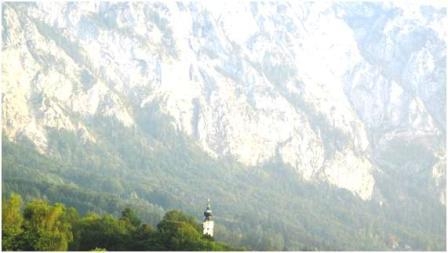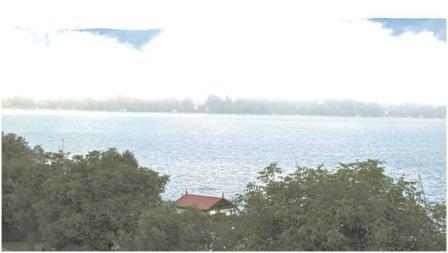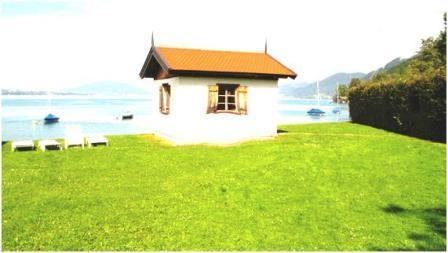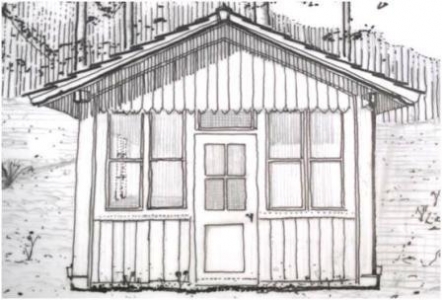
‘I have got down to work! That is the main thing! My cottage (in the meadow), just built, an ideal place for me’
Mahler made this comment having taken possession of his first summer ‘composing house’. Understanding the significance of these small buildings and the role they played in his life are key to understanding Mahler.

Mahler saw this landscape as he sat in his cottage at Steinbach in Upper Austria.
As an architect I am fascinated by the contribution that buildings make to our lives. The nature of buildings- their form, composition, fenestration, materials and overall architectural expression are important. But other architectural issues matter too. Spaces between buildings have a huge impact and explain why many urban settlements are special. Some streetscapes in Europe and beyond are so rich in quality that it is a pleasure to walk down a street and observe.
The idea that buildings play an important part in our lives is a concept that many scholars have considered. Architectural determinism is based on the notion that buildings and their surroundings determine behaviour. Buildings influence our mood; they lift spirits and celebrate human achievement. Winston Churchill touched on the significance of buildings during a parliamentary speech in 1943. He said, ‘we shape buildings, thereafter buildings shape us”. The Roman civilisation too recognised the part played by these factors and their influence. They felt that for each person in their society there was one place, superior to any other- a building, city or wilderness. They called this special place- this spiritual home, the genius loci.
The emergence of Mahler as an international music figure has attracted the attention of academics including historians and musicologists. It is rare for an architect to contribute to the debate. This is one reason why this study- Mahler’s Heavenly Retreats is distinctive. The approach used here looks at key and hitherto undervalued aspects of Mahler’s life. It considers important architectural buildings that he knew personally, building-in-use studies including environmental, geographical, contextual and experiential issues that helped shape Mahler’s music. It looks at sights and sounds he witnessed and how these impacted on him. But which buildings and their environments were important and what part did they play in Mahler’s life?
Mahler spent a huge amount of time travelling around Europe and beyond. For the most part he journeyed by train- flight was not an option! He crossed Europe conducting the works of others, arranging for the performance of his own music and composing. (He visited London in 1892- see presentation scheduled for 25th May 2011.) Up until 1892 he had established an extremely successful career as a performing musician- as a conductor he had secured Directorships in leading European opera houses in Budapest, Leipzig, Hamburg and would go on to secure the venerated post at The Imperial Opera House in Vienna. But he struggled to find time to compose, an essential aspect of his life and work: he needed to organise his summers.
He arranged for the construction of three small buildings- Music Pavilion, Studio, Hut, Composing House, Summer House, Forest House, Cellar; they are referred to by a variety of names. It would be in these tiny buildings that he would create huge musical structures. They would be constructed one after another, (there were only a few years when a hut was not available), and would be for Mahler’s sole use- generally between 1894 and 1910; June - September. But why was it necessary to take such drastic action? The locals at the first Cottage in Steinbach felt it was a strange decision to build a tiny structure in a flower meadow. They couldn’t see the point of it. Why would a composer want to sit in a small hut miles from anywhere, only emerging mid- afternoon after an early morning start?

Here the roof of Mahler’s Cottage is visible above the line of the surrounding trees- a mist hovers over the Attersee creating a very special atmosphere.
Mahler was bothered by noise. His architect’s dog, background noises, screeching birds and the sound of brass bands at inappropriate times bothered him. He was tortured by extraneous sound and this was a constant source of irritation, particularly while he was composing.
Did his way of working; writing down music rather than using a piano, demand heightened level of concentration? In any case his attempts to work within close proximity of friends and family was unsuccessful. He thought that a special place for him, in the right location would solve his problems. He became so single minded about the need for peace and solitude that later when his workspaces were constructed he succumbed to bizarre methods to maintain the right conditions for his work. These included the use of scarecrows and the firing of blank shot to keep birds and animals at safe distance. He also arranged for the construction of a high-level fence to prevent disturbance from unwanted visitors!
During a presentation to Gresham College on July 9th 2008 the focus was on Mahler’s second hut- his Forest House. For continuity purposes only, brief reference will now be made to this. The remainder of this presentation will focus on the other two buildings and their environment, the first and third retreat. As the name implies the second hut- the Forest House, lies deep inside a forest. 0ne-steps deeper and deeper into a private world. It is located in southern Austria and sits above another building that Alfred Theuer, Mahler’s architect, designed at the same time- Villa Mahler. It is a beautiful location, now very popular with holidaymakers. Clearly this place agreed with Mahler- during the seven summers he was there he created five symphonies plus other significant works. Mahler would start his day with a swim followed by an early morning walk to his Forest House- a pattern he would repeat at Steinbach.
Cottage at Steinbach- Upper Austria beside the Attersee (1893-1896)
Mahler’s first place for composition is some 30 miles east of Salzburg in a famous region known as the Salzkammergut. This region comprises some 40 lakes and was formed after the Ice Age when glaciers receded and melted leaving a deeply gouged landscape. Later valleys filled up with melted ice producing a series of lakes and breathtaking scenery. Mahler’s Cottage, was built beside one such Lake- the Attersee, which is the largest and longest in the region. (13 miles long and 1-2 miles wide.) It often takes on a blue hue though one of the fascinations with this place is its changing appearance.

Mahler’s Cottage sat in a flower-meadow- this is not the original location. It was moved some 40 metres following development of the neighbouring camp site

This view is from Mahler’s Cottage- across the Attersee and beyond.
Across the water one can glimpse a green rolling landscape. But to the east, the landscape takes on an entirely different form. Here lies The Höllengebirge, literally the mountains of hell- an outrageous outcrop of limestone that dominates this place.
During the early mornings he swam and later hiked and cycled with friends and family, making full use of the recreational opportunities offered. The Cottage built especially for him by a local builder is a simple rectangular building with a duo-pitched tiled roof and rendered external walls. It sits within a landscape that may be considered as a kind of symphony in itself- it has moments of repose, but ever present is the truly dramatic gesture of a heroic environment. This scene is combined with the delicate sound of the wind blowing through trees, lapping water and distant cowbell. The views, atmosphere and joy of this place inspired Mahler. One wonders what he felt as he sat creating the end of the Second and the whole of his Third Symphony? The massive and overwhelming character of this location inspired the cataclysmic ending to the Second Symphony and the beginning of the Third. The second movement of this symphony, ‘what the flowers tell me’, was written with a backdrop of flowers that circled his cottage.
Mahler resided in the local Inn between 1893 and 1896 and fell in love this place. At the end of his period here he climbed the hill overlooking his cottage and burst into tears. His daily walk down to his workplace, punctuated by views across the Attersee and The Höllengebirge, marked some very happy summers and coincided with the creation of extraordinary music which was produced alongside some of the most beautiful scenery in Europe. He left because of problems with renewing the lease. But it was not long before he had arranged for the construction of his second hut, (1901-1907). See transcript from previous Gresham College presentation dated 9th July 2008. Consideration will now be given to his third and final space for composition- his Summer House in the South Tyrol.
Summer House in the Dolomites, South Tyrol (1907-1910)
Each of Mahler’s summer retreats has a distinctive character- here in the South Tyrol Mahler spent three summers where he composed The Song of the Earth, the 9th and unfinished 10th symphonies. Again the landscape is stunning. This time Mahler’s hut is not beside a lake but in a more remote corner and separate from the main valley. Along this valley running north/south are three lakes – Toblacher See, Dürrensee and Misurina and these provide wonderful reflections of the landscape. Perhaps this site is the most beautiful of the three Mahler retreats. It was at Lake Misurina that Mahler had an epiphany- an intense emotional experience that led him to return to his hut and progress his music.

Mahler’s Summer House in Dobbiaco. (Formally Toblach). It is a very simple building sitting beneath tall pine trees. The building faces north and is blessed by sunlight during early morning and late evening.
Mahler’s Summer House consists of a simple building, timber structure and cladding with a tiled roof. It provided a small space in which to compose. Each day Mahler would walk from the local farmhouse where he lived with his wife and daughter. His need to spend his summer here was so great that he made the return journey from America each summer on three occasions. Again the established pattern of work served him well: early morning start followed by recreational activities. Here the walks were limited in scope as a result of his failing health. The visit for the summer 1910 was to be his last- he died in Vienna on May 18th 1911 at 11.05pm- one hundred years to the day from the date of this presentation!
Mahler’s Heavenly Retreats and their part in his life
Mahler referred to the fact that his huts were damp, (they had no damp-proof course), and probably had a detrimental effect on his health. But they did go a long way to provide the right environment for him and his art. They were his ‘fireplace’- a place of safety, free from the concerns of conducting orchestral music and opera. The cottage at Steinbach and the Summer House in the Dolomites provided an excellent space in which to work. The locality enabled him to hike, run, cycle, swim and visit health spas and these recreational activities coupled with time to compose made him feel relaxed and communicative. The mountains, forest and lake inspired him. His symphonies emanated from the sounds he heard and he wrote down ideas during his various excursions as he observed his surroundings. Each of the three

The Ferry Landing Station as it is today. Here Mahler greeted Bruno Walter and later played for him in his Cottage a piano version of his Third Symphony.
buildings exists today containing graphical material that describe Mahler’s period of occupation.
He frequently referred to the fact that musical ideas came to him within a day of two of arriving at his summer retreat. Mahler’s Third Symphony, for example, is dedicated to the wonder of the natural world in all its forms- the beautiful and the grotesque and is inextricably connected with the morphology of the site where it was written. Mahler made this connection in a comment to Bruno Walter when he greeted him at the landing station at Steinbach on the 17th July 1896. Both remarked on the beautiful day but it was his visitor’s look at The Höllengebirge, the great rock face that dominates the Attersee that prompted Mahler’s remark. ‘There’s no need to look at that’, he said, ‘it’s all in my music”.
Clarke K. J. Mahler’s Heavenly Retreats: Encounters with the Master’s ‘Composing Houses’ Oblique Angle Publishing. 2007 (Includes DVD and CD).
All drawings and text: ÓKeith James Clarke, Gresham College, 18th May 2011